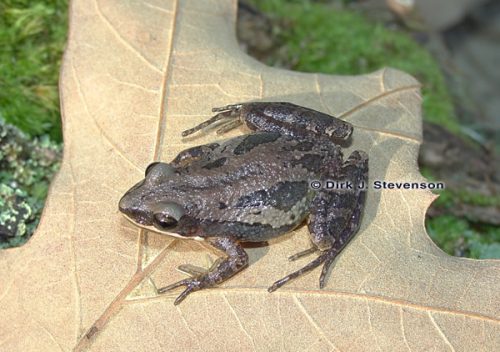Southern Chorus Frog
Scientific name: Pseudacris nigrita
These small, stout frogs have bumpy skin and spotted markings that are ideal camouflage in their pine wood habitats. They are shy and nocturnal, so they’re difficult to find, but their unusual chirping call is recognizable at night in their favorite habitats.
Appearance

Small and bumpy, usually .75 to 1.25 inches long. Color ranges from green-gray to tan or brown. They usually have broken lines or rows of dark spots or blotches on their backs and legs. Their upper lip is usually distinctly lighter and their snout is somewhat pointed.
Behavior
Southern chorus frogs generally live in pinelands or pine savannas where there is sandy soil to burrow into. They’re also found in limestone sinkholes. During the breeding season they move closer to shallow, temporary pools, water-filled ditches and canals, or flooded fields near pine woods. They are quite shy, and even calling males will hide in grasses or holes, or mostly submerge themselves in water. Because they are so shy, not a lot is known about them, but it is believed they burrow into sandy soil and spend a good deal of the dry seasons underground.
Sound
Southern Chorus Frog
Food
Insectivores. They eat mainly ants, beetles and other small insects.
Habitat & Range
- Mainly the southeastern United States (west to Louisiana and north into North Carolina and small areas of Virginia)
- Florida: Statewide except for the Keys. Native.
- They are terrestrial, which means they live at ground level, usually under leafy plants and grasses.
Notable
Although the Southern chorus frog has a somewhat robust population in its range, researchers note with concern that a great deal of the frogs’ preferred old-growth longleaf pine habitats are being replaced with farmed slash pine at a rapid rate.